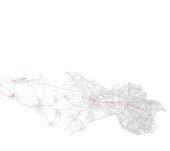V E S T I G
E S of G R I

E S of G R I
an I M P E T U S of H O P E
MASTER’S RESEARCH PROJECT THESIS by DAVID GOMEZ
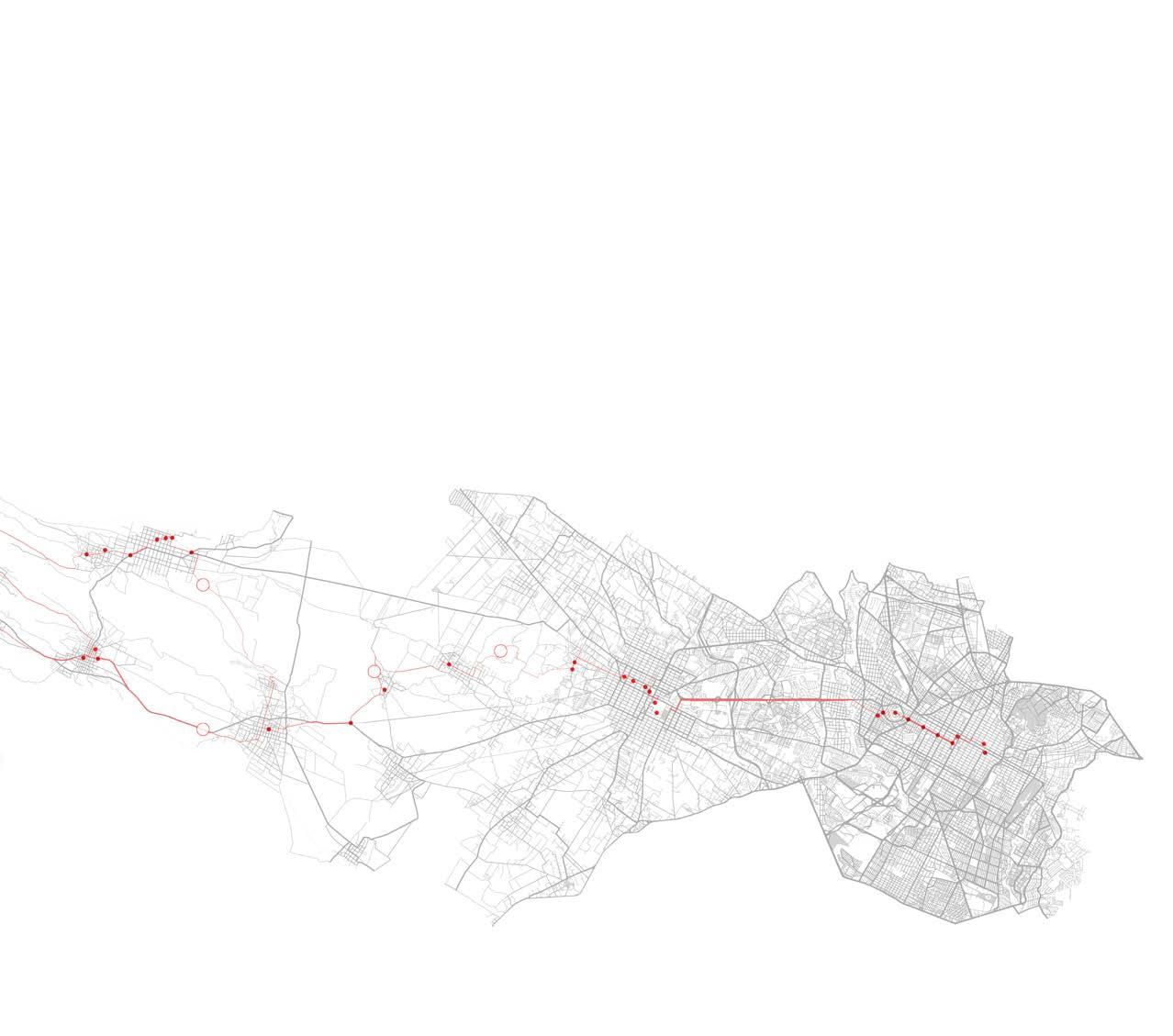
VESTIGES of GRIEF : an IMPETUS of HOPE MASTER’S RESEARCH PROJECT THESIS by DAVID GOMEZ
SUPERVISORY COMMITTEE MEMBERS
CHAIRMAN: BRADLEY WALTERS
CO-CHAIRMAN: SARAH GAMBLE
Fig. 01
Fig. 02
Fig. 03
Fig. 04
Collection of hand drawn sketches.
United Nations High Commissioner for Refugees (UNHCR) Interactive story map.
Documented series of photographs by Daniel Berehulak for The New York Times.
Synthesis of main issues faced by displaced communities, as identified by the author through the extensive research of stories behind displaced communities around the globe.
Fig. 05
Fig. 06
Fig. 07
Fig. 08
Fig. 09
Fig. 10
Fig. 11
Fig. 12
Fig. 13
Fig. 14
Fig. 15
Fig. 16
Fig. 17
Fig. 18
perspectival rendering of
Exterior perspectival rendering of the warm interval haven, located in Lithgow, Australia.
Axonometric diagrams of the cold interval haven, exploring elements of transparency, structure and wind obstruction.
Cross Section.
Longitudinal Section.
Set of architectural plans showcasing the spaces in relationship to the cleaving core.
Interior perspectival rendering, portraying the space of felting.
Interior perspectival rendering, portraying the space of dwelling.
Axonometric diagrams of the warm interval haven, exploring elements of transparency, structure and wind filtering.
Cross Section.
Longitudinal Section.
Set of architectural plans showcasing the spaces in relationship to the site context.
Interior perspectival rendering, portraying the space of meditation.
Photograph of Nizip II by Tobias Hutzler, a container camp in Turkey on the Syrian border. Exterior the cold interval haven, located in Siglufjörður, Iceland.Fig. 19
Fig. 20
Interior perspectival rendering, portraying the space of dyeing.
International Organization for Migration (IOM) map, showcasing a synthesis of mixed transit routes used by displaced communities across Central America and Mexico.
Fig. 21
Fig. 22
Fig. 23
Fig. 24
Fig. 25
Fig. 26
Fig. 27
Fig. 28
Fig. 29
Fig. 30
Fig. 31
Fig. 32
Fig. 33
Fig. 34
Fig. 35
Fig. 36
Fig. 37
Fig. 38
Fig. 39
Fig. 40
Photograph by Daniel Berehulak for The New York Times, documenting a group of displaced individuals walking along railroad tracks north through Mexico.
Photograph by the U.S. Fish and Wildlife Service, showcasing the Desert landscape on the Cabeza Prieta National Wildlife Refuge.
Digital photograph by author of trails surrounding the Landmannalauger area.
Trek between Landmannalauger and Hrafntinnusker.
Trek between Hvanngil and Botnar.
Elevation profile analysis of Laugavegur in Iceland.
Trek between Takahara and Chikatsuyu-oji.
Trek between Tsugizakura-oji and Fushiogami-oji.
Elevation profile analysis of Kumano Kodō in Japan.
Pilgrim’s Column by Christ & Gantenbein.
Crosses Lookout Point by Elemental.
Elevation profile analysis of The Pilgrim Route in Mexico.
Synthesis of necessities identified and categorized through the extensive research of The Pilgrim Route project in Mexico.
Iglesia de Santiago de Barbadelo.
Village of Portomarrin.
Elevation profile analysis of The Way of St. James in Spain.
Image Map of the Vestiges of Grief: an Impetus of Hope proposed route in Mexico.
Photo by the San Andres Calpan community, showcasing the sculptural work of Dr. Antonio Haghenbec.
Small scale mapping of the Vestiges of Grief route in Mexico Cerro Zapotecas, depicting the first glimpse of the entire route.
Fig. 41
42 Fig. 43
Fig. 44
Fig. 45 Fig. 46
Fig. 47
Fig. 48
Fig. 49
Fig. 50
Fig. 51
Fig. 52
Fig. 53
Fig. 54
Fig. 55
Fig. 56
Fig. 57
Fig. 58
Volcan Iztaccihuatl, portraying the culmination of the route at the highest point between both volcanoes.
Elevation profile analysis of the Vestiges of Grief route in Mexico.
Elevation profile diagram comparison and contrast between all case studies and the Vestiges of Grief route.
Series of signage traces on natural textures, showcasing the varied ways in which the guiding mark from the Vestiges of Grief would be encountered along the route.
Digital Illustration of the Vestiges of Grief route, showcasing the occupation of paths throughout natural landscapes and incorporating the use of signage to guide the users along the trail.
Large scale mapping of the Vestiges of Grief route, showcasing in detail the tailored itinerary of the journey based on the stages of grief.
Collection of hand drawn sketches.
Series of gestural models made of white bristol and gray canson paper.
Vestiges of Grief route mapping, showcasing a close-up of the phase of denial
Axonometric drawing of the Vestige of Denial.
Hand drawn sketch of the pedestrian walkways within the historic center of Puebla.
Hand drawn sketch of historic buildings and monuments within the city of Puebla.
Hand drawn sketch interpreting the Vestige of Denial within the natural context of the Cerro Zapotecas.
Architectural plan, illustrating the various existing trails merging with the constructed carved path.
Longitudinal section, portraying the progression from the sloped entrance into isolation, to the slow reveal of the landscape.
Axonometric drawing close-up of the Vestige of Denial.
Fragment of the longitudinal section, showcasing the space of shelter and revitalization.
Digital Illustration of the main experience found within the Vestige of Denial. A focal view of the routes entirety revealed as the user exits the construct.
Fig. 59
Fig. 60
Fig. 61
Fig. 62
Fig. 63
Fig. 64
Fig. 65
Fig. 66
Fig. 67
Fig. 68
Fig. 69
Fig. 70
Fig. 71
Fig. 72
Fig. 73
Fig. 74
Fig. 75
Fig. 76
Fig. 77
Fig. 78
Fig. 79
Fig. 80
Vestiges of Grief route mapping, showcasing a close-up of the phase of anger.
Axonometric drawing of the Vestige of Anger.
Hand drawn sketch depicting the small town of San Francisco Coapa.
Hand drawn sketch of the rural areas surrounding the city of Pueb- la.
Hand drawn sketch interpreting the Vestige of Anger.
Architectural plan, illustrating the main layout of spaces surrounding a heavyweight core structure.
Axonometric drawing close-up of the Vestige of Anger.
Cross section, portraying the arduous climb of the cliff, revealing varied sets of spaces along the way.
Digital Illustration of the main experience found within the Vestige of Anger.
Vestiges of Grief route mapping, showcasing a close-up of the phase of bargaining.
Axonometric drawing of the Vestige of Bargaining.
Hand drawn sketch of the extensive rural areas followed after the phase of anger.
Hand drawn sketch of the small town of San Buenaventura Nealtican,
Hand drawn sketch interpreting the Vestige of Bargaining.
Architectural plan, illustrating the series of spaces influenced by the central void within the structure.
Longitudinal section.
Axonometric drawing close-up of the Vestige of Bargaining.
Digital Illustration of the main experience found within the Vestige of Bargaining.
Vestiges of Grief route mapping, showcasing a close-up of the phase of depression.
Axonometric drawing of the Vestige of Depression.
Hand drawn sketch depicting the small town of San Andres Calpan.
Hand drawn sketch of the nature-driven path found as the users approach the base of the volcanoes.
Fig. 81
Fig. 82
Fig. 83
Fig. 84
Fig. 85
Fig. 86
Fig. 87
Fig. 88
Fig. 89
Fig. 90
Fig. 91
Fig. 92
Fig. 93
Fig. 94
Fig. 95
Fig. 96
Fig. 97
Hand drawn sketch interpreting the Vestige of Depression.
Architectural plan, illustrating the set of spaces generated as a result of the heavyweight series of planes rooted within the cliff.
Longitudinal section, portraying the progression from entering the rooted structure, guided by existing trails within nature.
Axonometric drawing close-up of the Vestige of Depression.
Digital Illustration of the main experience found within the Vestige of Depression.
Vestiges of Grief route mapping, showcasing a close-up of the phase of acceptance.
Axonometric drawing of the Vestige of Acceptance.
Hand drawn sketch depicting the changing natural atmospheres as each individual progresses through the nature-driven trek uphill.
Hand drawn sketch of the elevated paths toward the Vestige of Acceptance.
Hand drawn sketch interpreting the Vestige of Acceptance
Architectural plan, illustrating the set of spaces generated surrounding the guiding beacon.
Axonometric drawing close-up of the Vestige of Acceptance.
Longitudinal section, portraying the progression from entering the lightweight beacon, and experiencing the varied spaces surrounding the vertical structure.
Digital Illustration of the main experience found within the Vestige of Acceptance.
Vestiges of Grief route mapping, showcasing a close-up of a phase beyond acceptance, driven by an impetus of hope.
Hand drawn sketch depicting the moments of reflection offered through bodies of water along the descension from the volcano trail.
Hand drawn sketch illustrating the transition from the natural environ- ment offered by the volcanoes to the reintroduction to the metropolis.
Vestiges of Grief: an Impetus of Hope · David Gomez
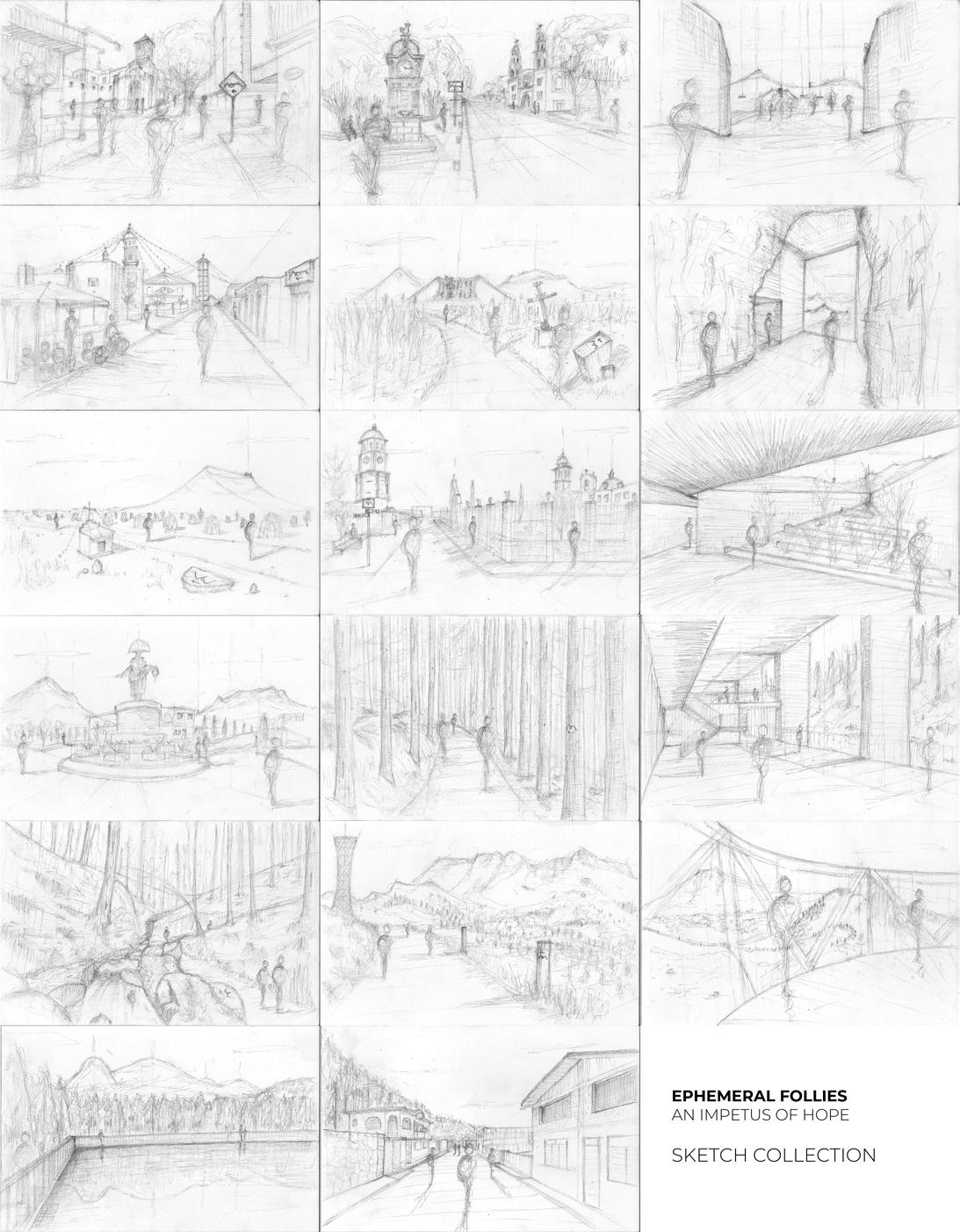
VESTIGES of GRIEF
an IMPETUS of HOPE

The displacement of communities from their homeland is a phenomenon that has constantly impacted the entire globe. This reality has demanded us to seek valuable solutions that address the realities faced by these moving individuals that travel with the sole purpose of pursuing an opportunity to strive and get a chance at living in a safe and inclusive environment. The states of uncertainty and distress these refugees experience throughout their voyage lack the moments of pause and reflection needed to thoughtfully resolve the best outcomes within their journey, leaving them with an absence of clarity as to what their future conceals.
The idea behind the Vestiges of Grief: An Impetus of Hope conceptualizes the act of walking as a medium of thought by exploring the development of spatial instances that work as a catalyst between the mental state of limbo and certitude. A bridge consisting of thought-inducing spaces that are deeply embedded within the lore of the region and deployed in strategic intervals that reminiscence the stages of grief throughout the course of seeking resolution. The vestiges of grief would allow the architecture to channel the engagement between the physical movement and thought process of each individual, guiding and revealing the outcome of their decisions.
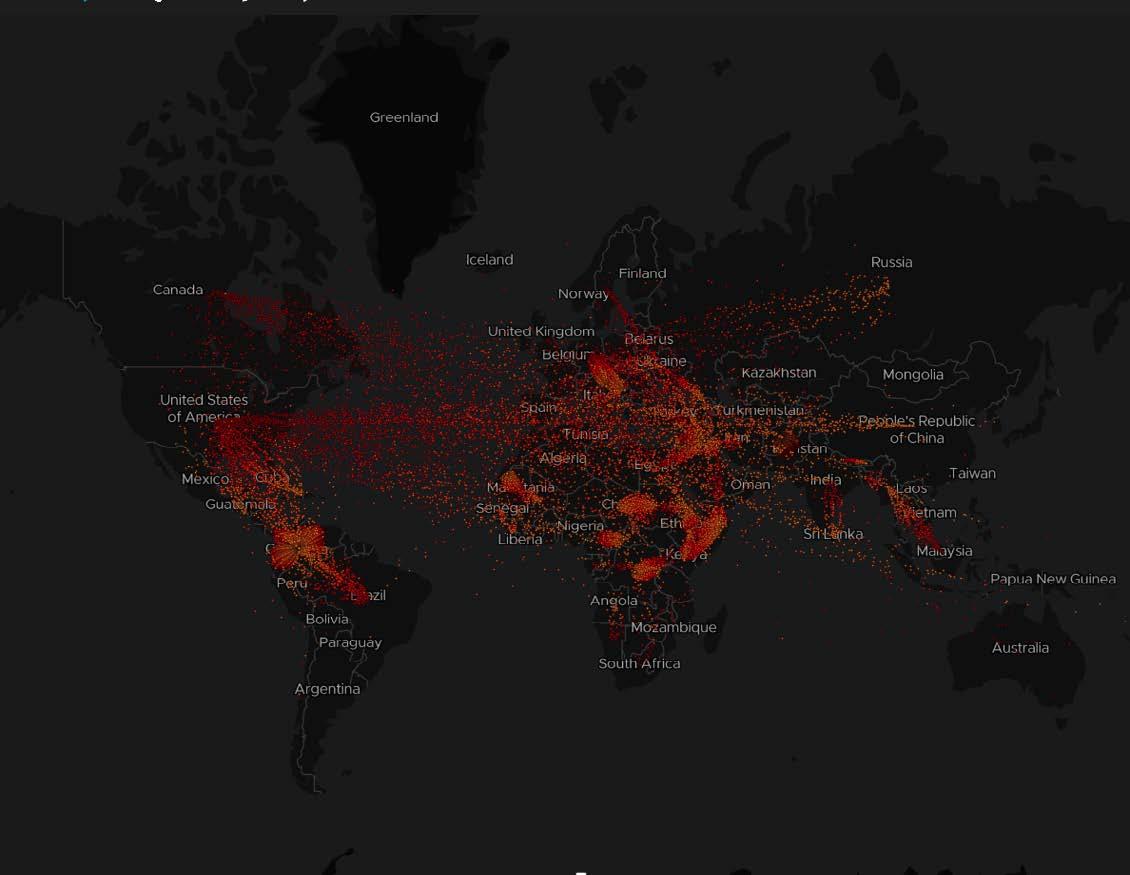
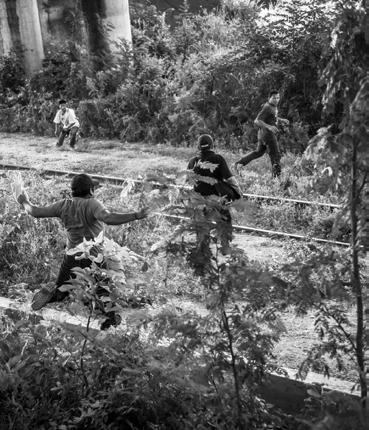
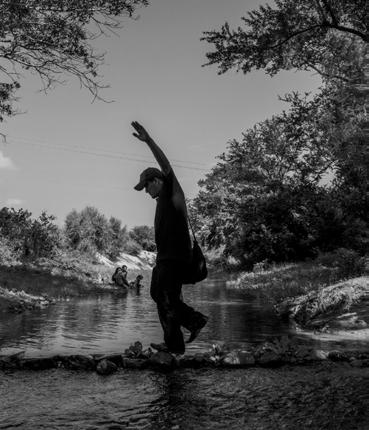
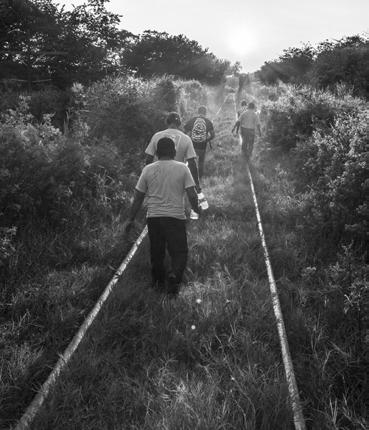
The constant movement of communities forced to escape their homeland due to unexpected circumstances is a humanitarian reality faced by individuals around the world. These communities are subject to travel great distances by land or sea while carrying only their most fundamental belongings in order to improve their chance of survival and ability to reach their final destination safely. However, the journey ahead for most travelers is usually met with various life threatening risks. Architizer columnist James Bartolacci, mentions how: “Without a permanent place to settle, and facing a lack of proper security and shelter, refugees face a disproportionately high rate of disease, mental illness, and violence, leaving millions in a state of extreme vulnerability.” 1
While there are groups of people who are capable of affording a safe and seamless transition to another nation without much difficulty, the journey for most of these displaced communities is often experienced through the most basic means of transportation, from walking long distances by foot, to the use of any available public transit services they can afford. The long trips tend to force these individuals into uncharted paths, causing them a sense of uncertainty, fear and anguish towards what the future might hold for them.
An uncertain period of awaiting a decision or resolution; an intermediate state or condition.
The global mass displacement of people around the world has been increasing exponentially, implicating territories that have never experienced this phenomenon before. The varied reasons behind these movements are described by the Office of the United Nations High Commissioner for Refugees (UNHCR) explaining how in 2015, “Individuals were forcibly displaced worldwide as a result of persecution, conflict, generalized violence, or human rights violations.” 2 Suggesting that in a state of displacement, being forced into a situation of such need, requires sacrifice and improvised judgment towards unforeseen events in order to strive and survive.
The migrant communities travel with the sole purpose of pursuing an opportunity to get another chance at living in a safe and inclusive environment where they can settle and make a planned decision as to what path is best suited for the next chapter of their lives. The uncertainty of time is just one of many unknown variables each individual must carefully consider in order to flesh out the best possible choices for them and their loved ones. However, most of the decisions taken by these displaced communities are forcibly improvised and rushed, thus, leaving them in a state of limbo; unable to go back to their homeland, and in most cases, unable to settle permanently. 3
2 UNHCR: The UN Refugee Agency, Global Trends: Forced Displacement in 2015, (2015), https://www.unhcr. org/576408cd7.pdf.
3 Jeff Crisp, No Solution in Sight: The Problem of Protracted Refugee Situations in Africa, (California, San Diego, 2003), https://escholarship.org/uc/item/89d8r34q.
The movement of masses escaping a common threat is often mistakenly regarded as a “temporary” problem.
Dwellings that serve their basic function at the cost of inadequate and inhumane living conditions.
Exclusion from the cultural and social environment from the host territory of asylum.
Isolation from the natural environment, generating a general disconnect from mother nature.
Lack of opportunities for healing, thought and resolve from a state of uncertainty and despair.
Synthesis of main issues faced by displaced communities, as identified by the author through the extensive research of stories behind displaced communities around the globe.The current immediate and temporary solution in order to host and allow for the asylum of these moving communities has been the use of camps. These camps would serve their basic function at the cost of inadequate living conditions. Unfortunately, it is common for most of these groups of people to be met with a similar or worse condition in which they lived in before they were displaced; isolated from their cultural and natural environment. Paola Ardizzola, Esin Bolukbas Dayi and Begum Soyek; faculty at the Antalya International University in Turkey; describe the importance in how “…a proper social life for refugees involves cultural expectations, activeness in local economy and integration with the hosting citizens, which can be considered the main and presumably the most difficult circumstances in front of us, a primary challenging matter for the future of many countries worldwide.” 4
The main focus of camps has been to provide the user with a limited shelter and environment, isolated from the cultural and social characteristics of the host territory. Marcus Fairs; founder and editor-in-chief of Dezeen; suggests that “…efforts should be made to shift the negative narrative around population movements and to help make cities better able to absorb incomers…”
5 Implying the idea of authorizing refugees to be incorporated within the community by allowing them to contribute and connect with their new surroundings while acquiring the sense of familiarity and cultural integration that was lost in the transition from the source hostile environment.
4 Paola Ardizzola, Esin Bolukbas Dayi and Begum Soyek, A shelter is not enough: a pattern for refugees’ social life, (2017), https://goo.gl/YREtkX.
5 Marcus Fairs, "Don't design yet another shelter" for refugees, say experts, (2017), https://www.dezeen.com/?p=1163771.
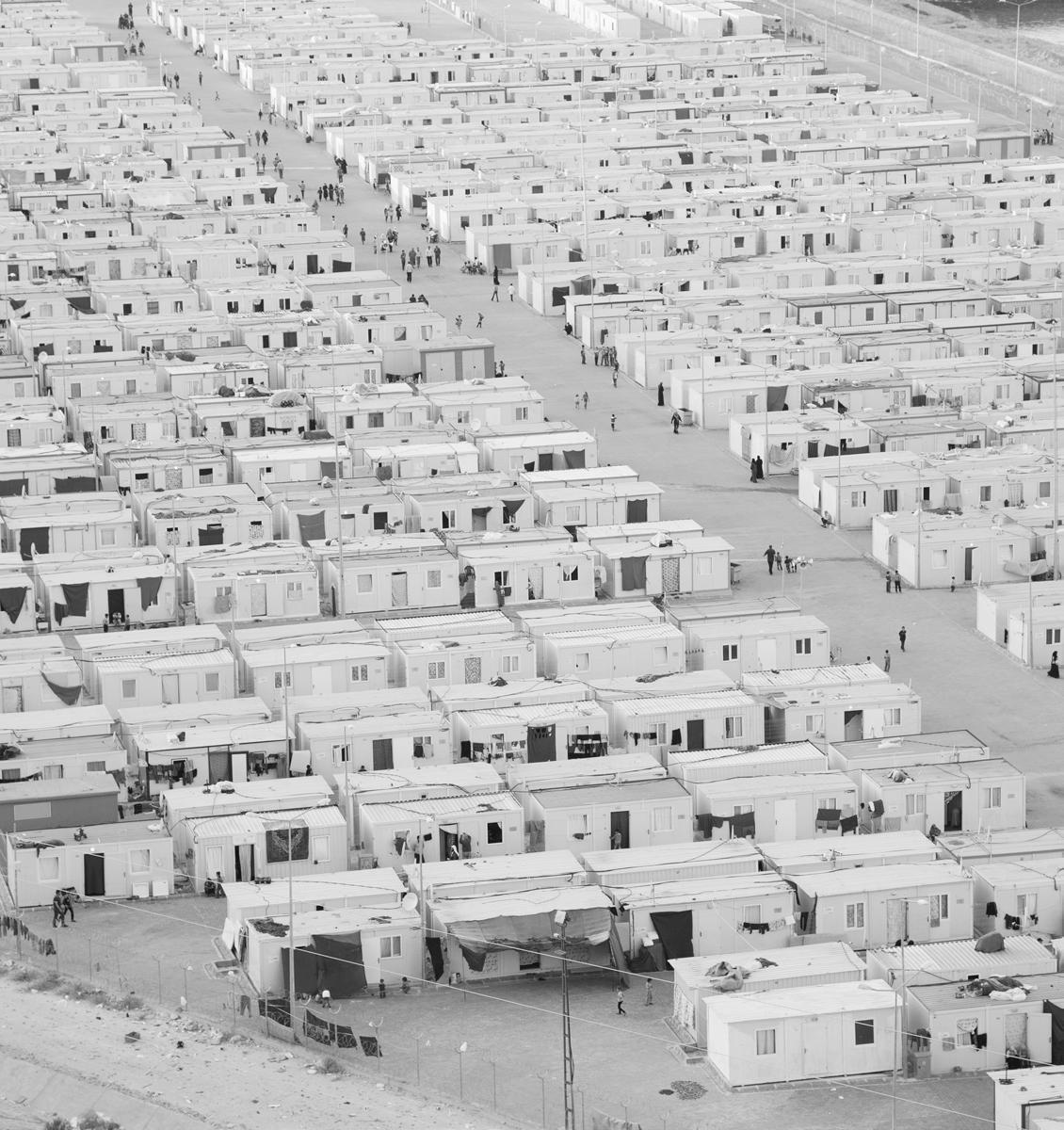 Photograph of Nizip II by Tobias Hutzler, a container camp in Turkey on the Syrian border.
Photograph of Nizip II by Tobias Hutzler, a container camp in Turkey on the Syrian border.
In response to the initial research, a design approach was developed that revolved around utilizing architecture as a catalyst to integrate the phenomenon of displaced communities within a specific region in the world. These proposed havens re-imagine the refugee safe-houses as individual homes that are deeply connected with the cultural and natural environment of the region. The constructs simultaneously consider both the human condition and the sites occupied as key elements towards a design approach that is inclusive of its context.
The itinerary behind each haven considers a duality of place within completely opposite extreme climates; hot and cold; based on the Köppen-Geiger climate classification system. The regions of operation; Siglufjörður in Iceland and Lithgow in Australia; were selected to reflect the current global widespread of displaced communities and the set parameters of extreme weather that reside in zones A and E from the mapping of world climate classification system.
Within these constructs, displaced individuals encounter a series of spaces for dwelling, meditating and working, generating a cycle that is based on being included within the culture of the region and giving back to the local community. The cold and warm interval havens would incorporate cultural practices such as felting and dyeing as the main disciplines, reminiscent of the old traditions from Iceland and Australia respectively. Additionally, these practices would work in conjunction with the ephemeral qualities of the environment, from the introduction or blockage of wind, shading strategies, and heating and cooling systems.
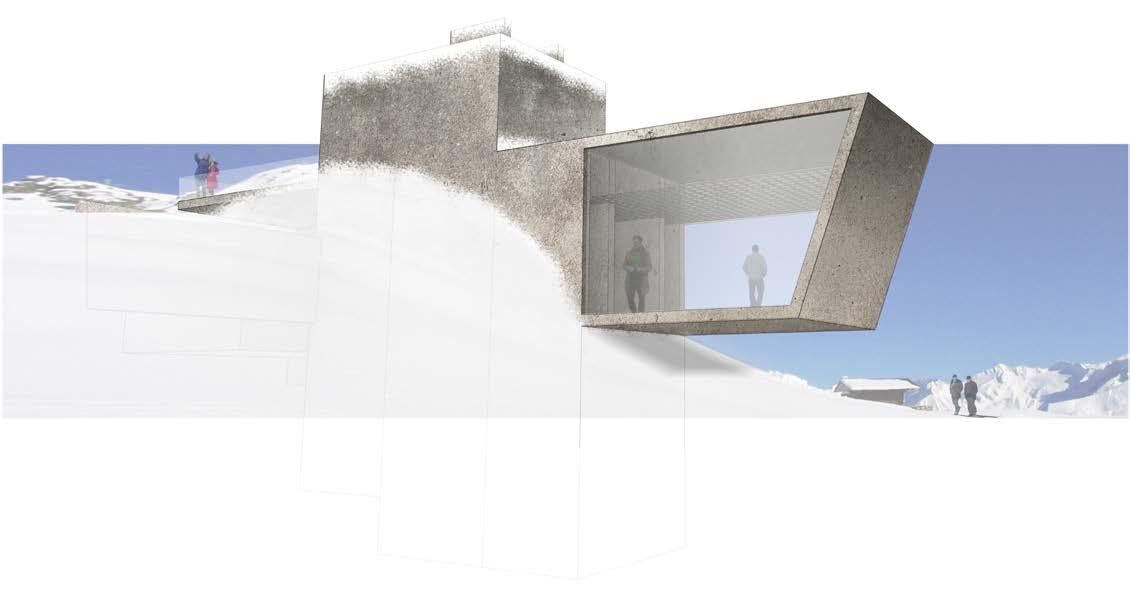
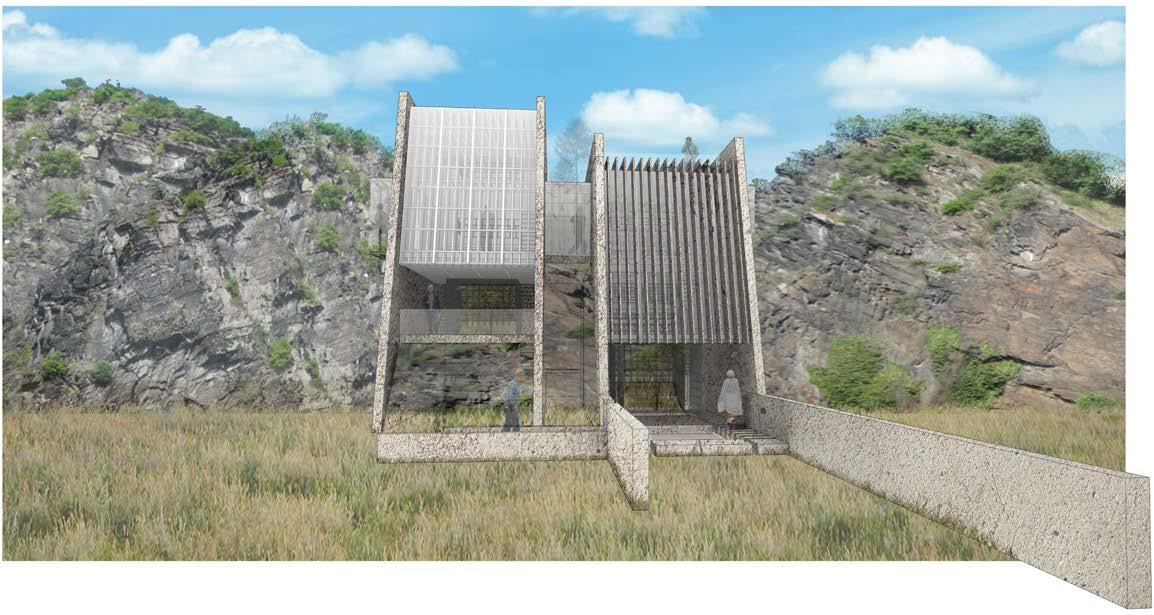 Exterior perspectival rendering of the warm interval haven, located in Lithgow, Australia.
Fig. 07.
Exterior perspectival rendering of the cold interval haven, located in Siglufjörður, Iceland.
Exterior perspectival rendering of the warm interval haven, located in Lithgow, Australia.
Fig. 07.
Exterior perspectival rendering of the cold interval haven, located in Siglufjörður, Iceland.
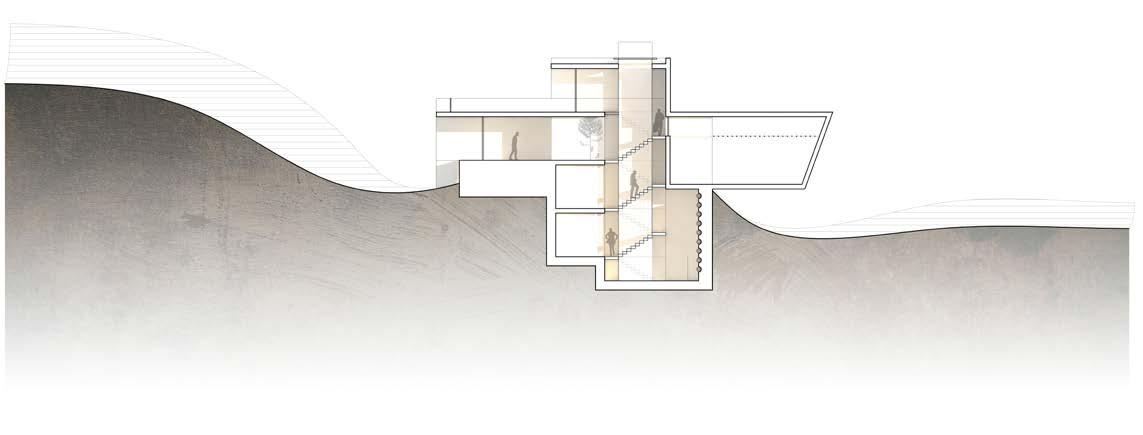
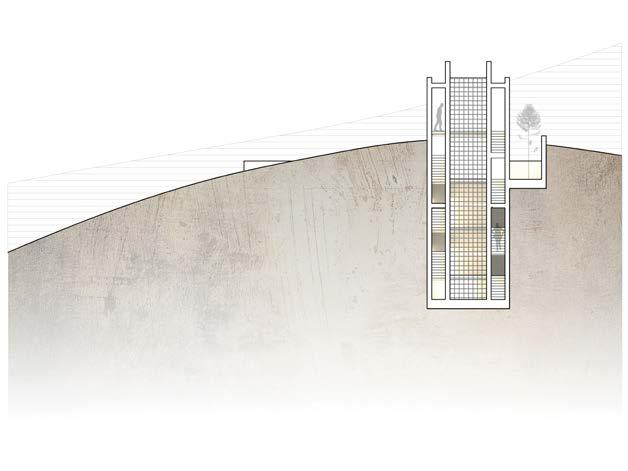
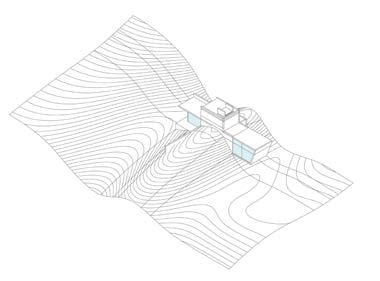
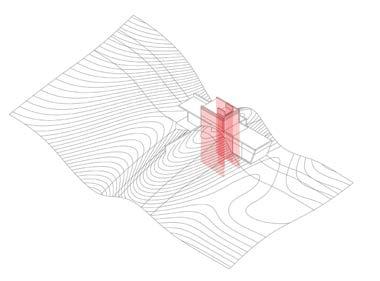
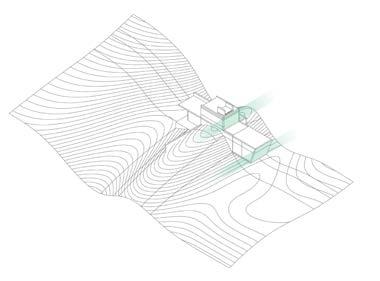 Longitudinal Section
Longitudinal Section
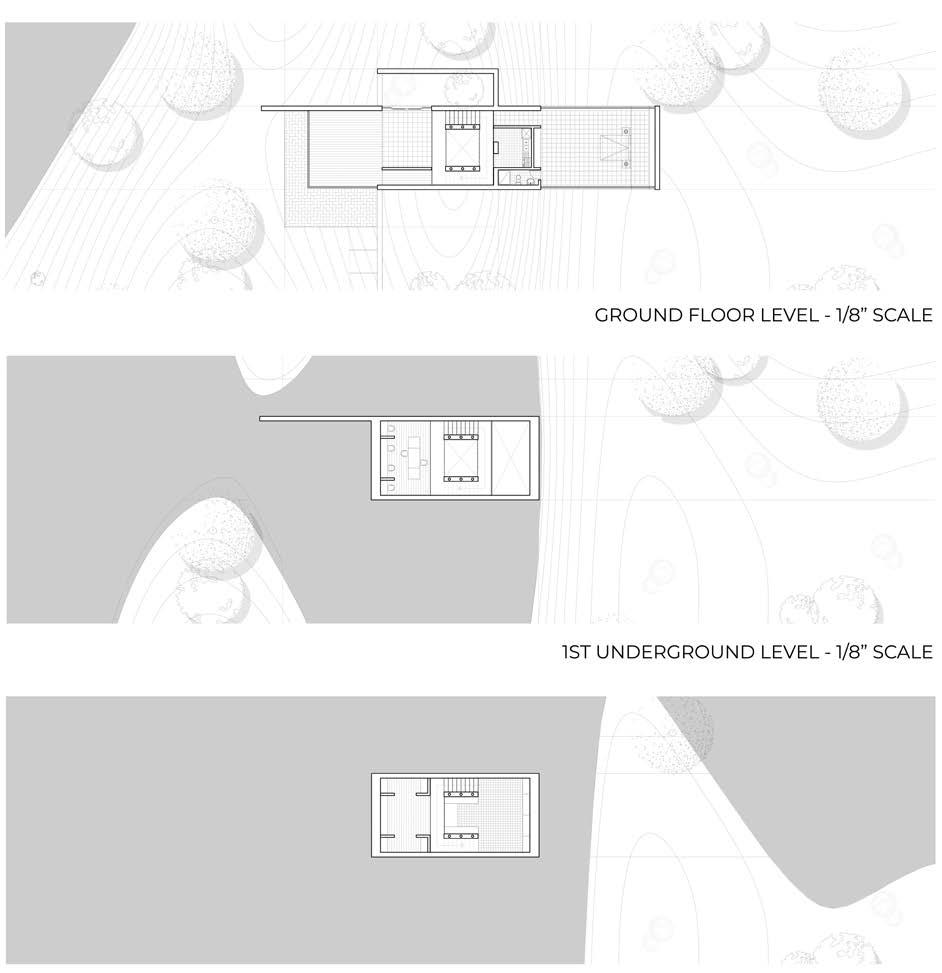
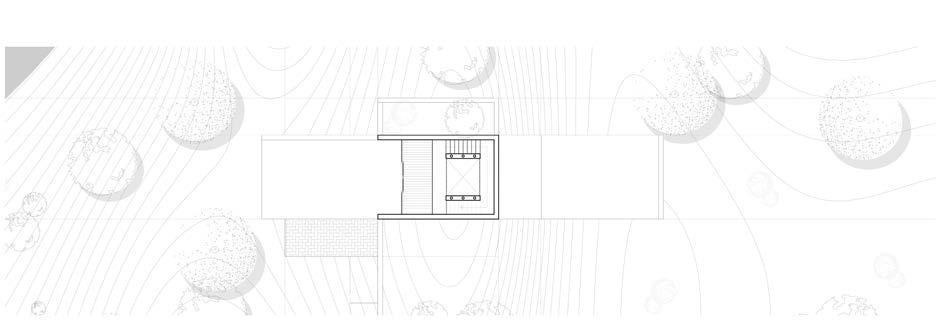
Interior perspectival rendering, portraying the space of felting at the lowest level of the structure, taking advantage of the cleaving gesture of the construct and utilizing the funnel to heat the spaces within the construct.
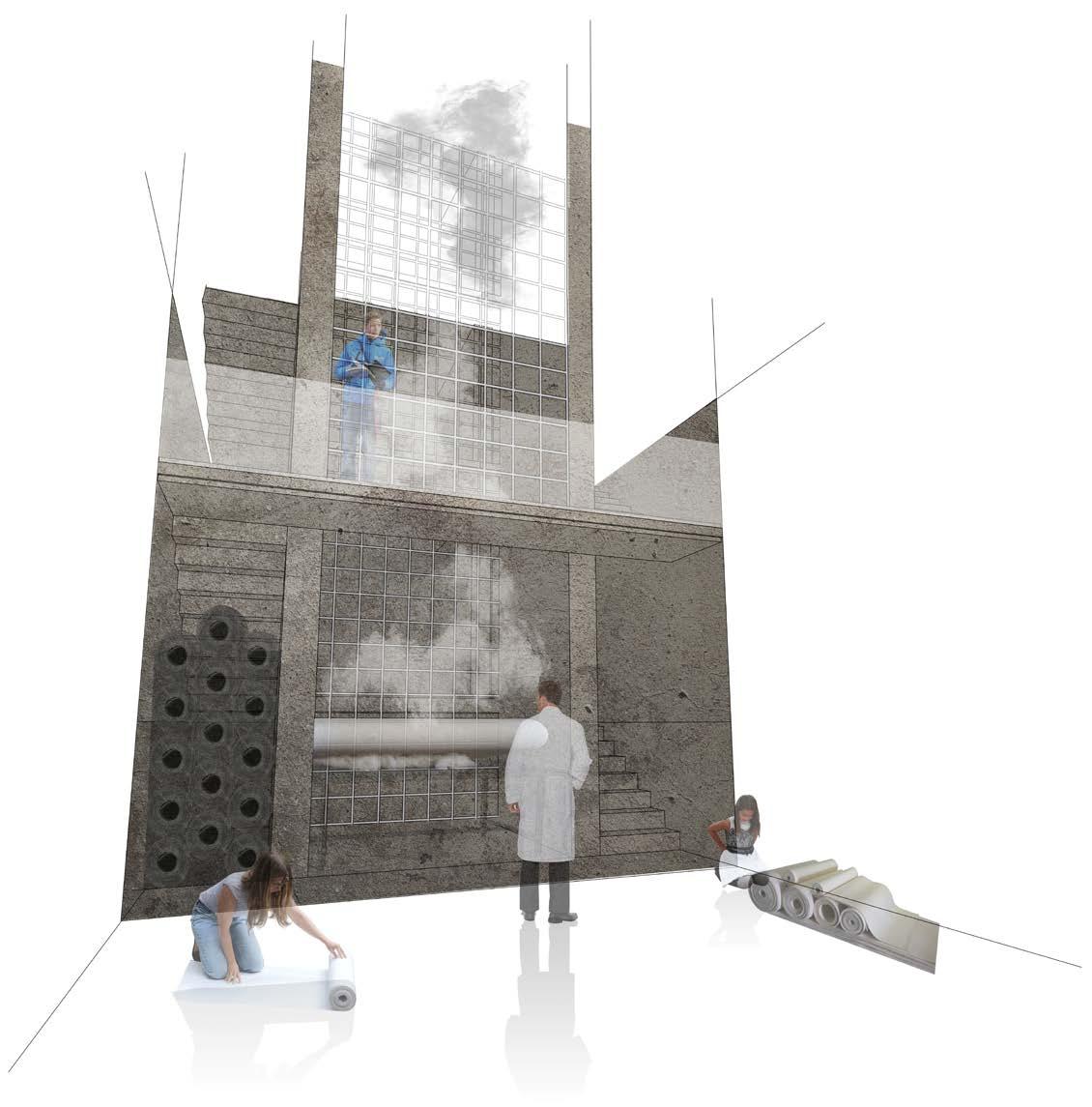
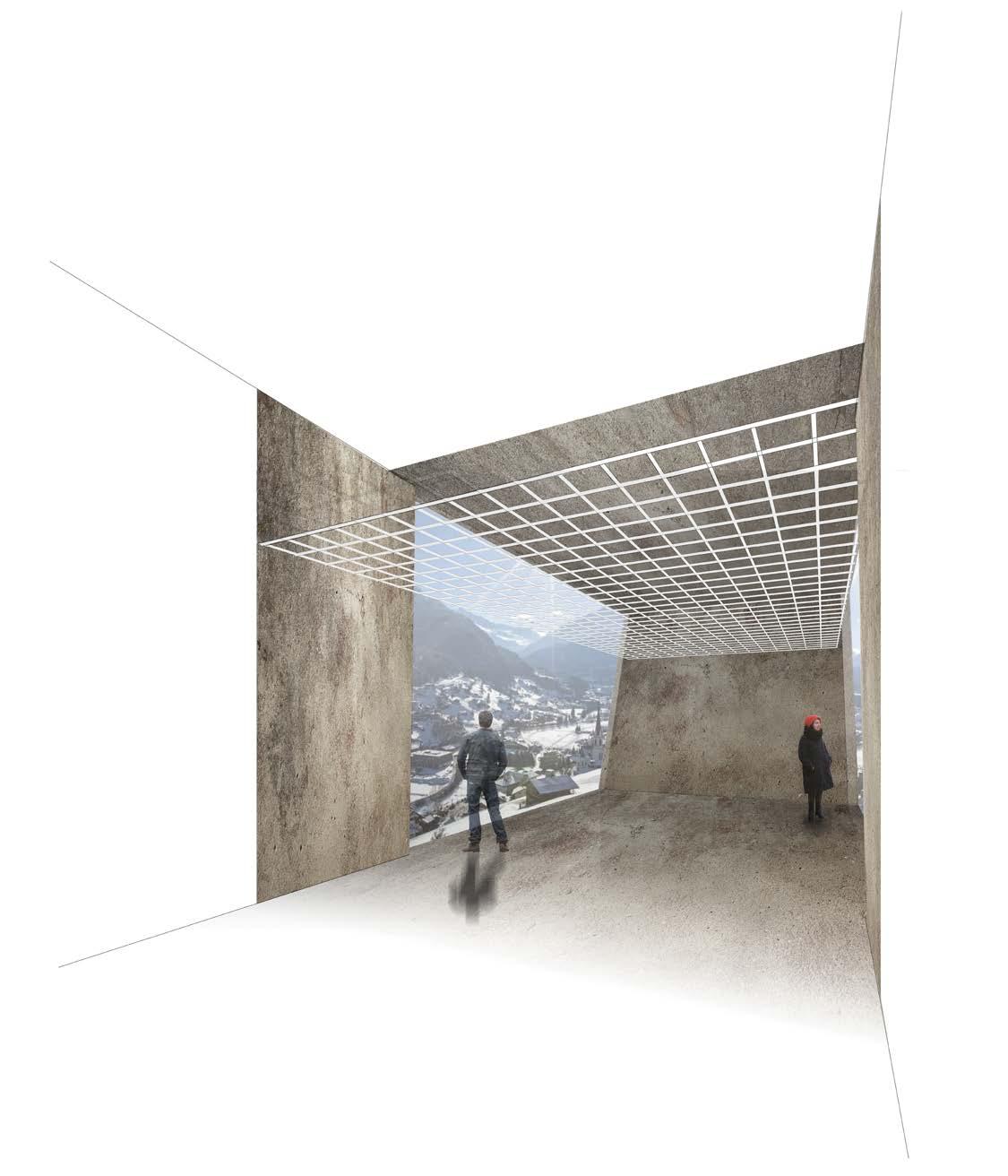 Interior perspectival rendering, portraying the space of dwelling where the visual connection between the construct and the city of Siglufjörður, Iceland is framed to generate a sense of belonging.
Interior perspectival rendering, portraying the space of dwelling where the visual connection between the construct and the city of Siglufjörður, Iceland is framed to generate a sense of belonging.
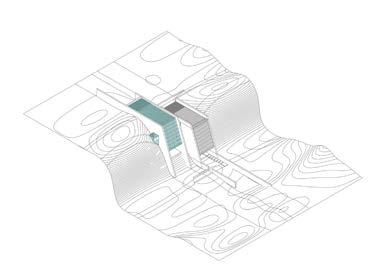
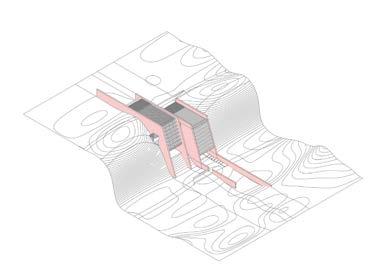
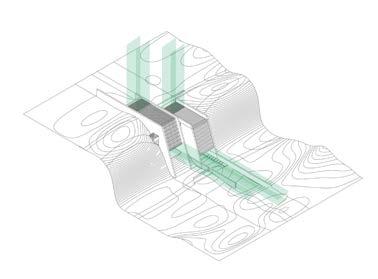
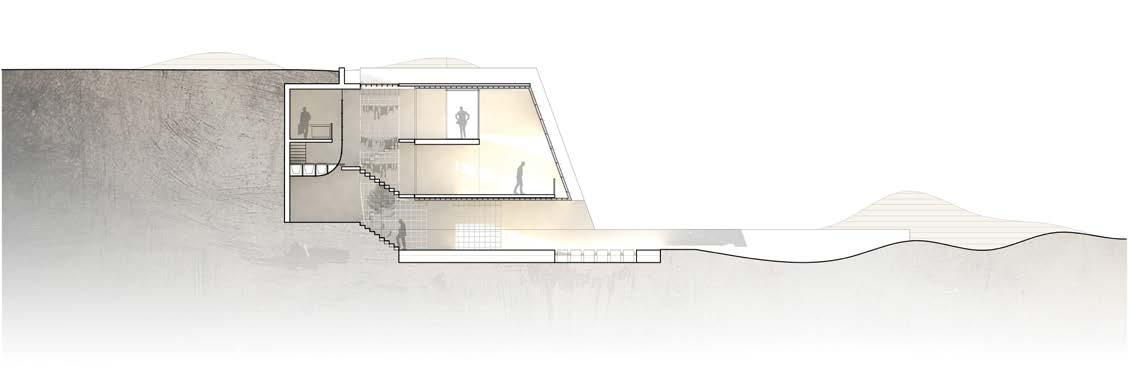
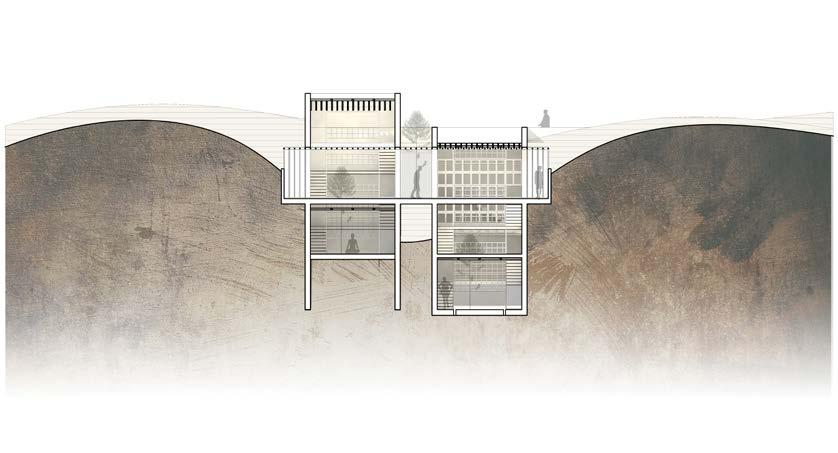 Longitudinal Section
Fig. 16.
Cross Section
Axonometric diagrams of the warm interval haven, exploring elements of transparency, structure and wind filtering.
Fig. 15.
Longitudinal Section
Fig. 16.
Cross Section
Axonometric diagrams of the warm interval haven, exploring elements of transparency, structure and wind filtering.
Fig. 15.
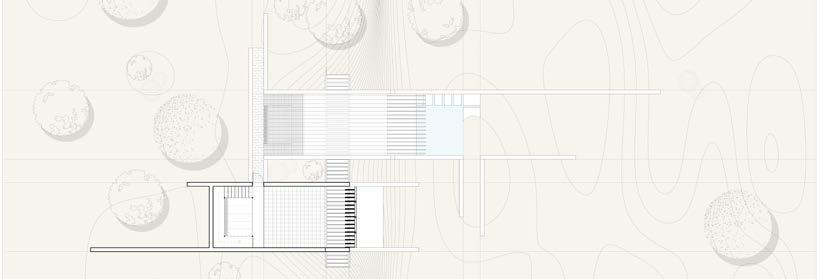
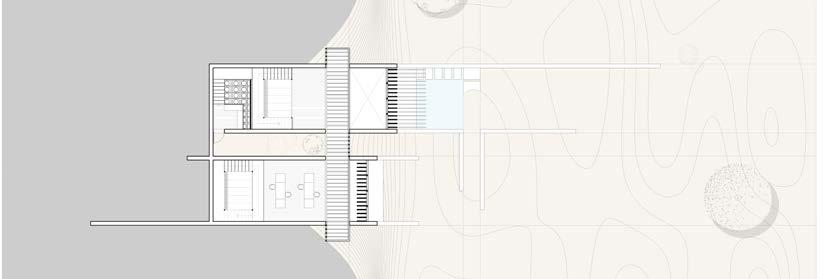
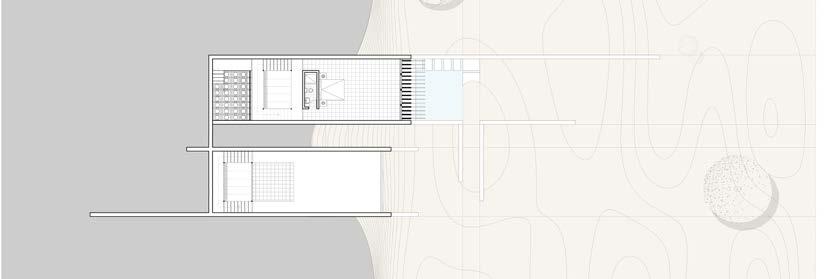
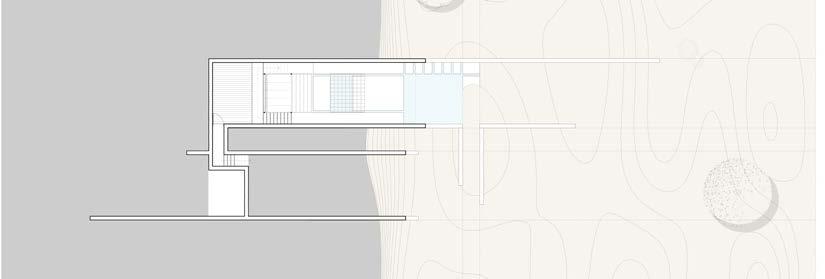
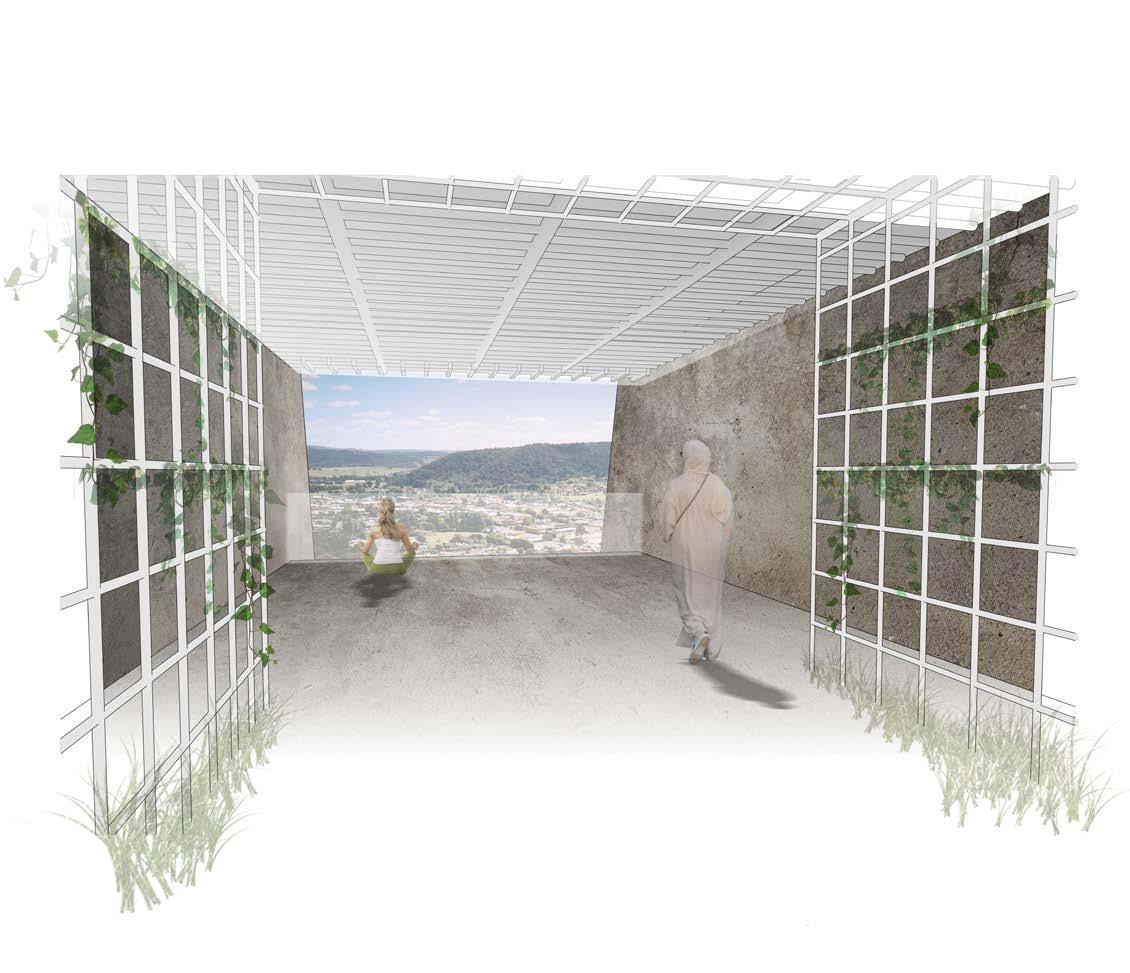 Interior perspectival rendering, portraying the space of meditation where the visual connection between the construct and the city of Lithgow, Australia is framed to generate a sense of belonging. The breeze would cool the interior of the construct, allowing the spaces to breathe in the warm climate.
Interior perspectival rendering, portraying the space of meditation where the visual connection between the construct and the city of Lithgow, Australia is framed to generate a sense of belonging. The breeze would cool the interior of the construct, allowing the spaces to breathe in the warm climate.
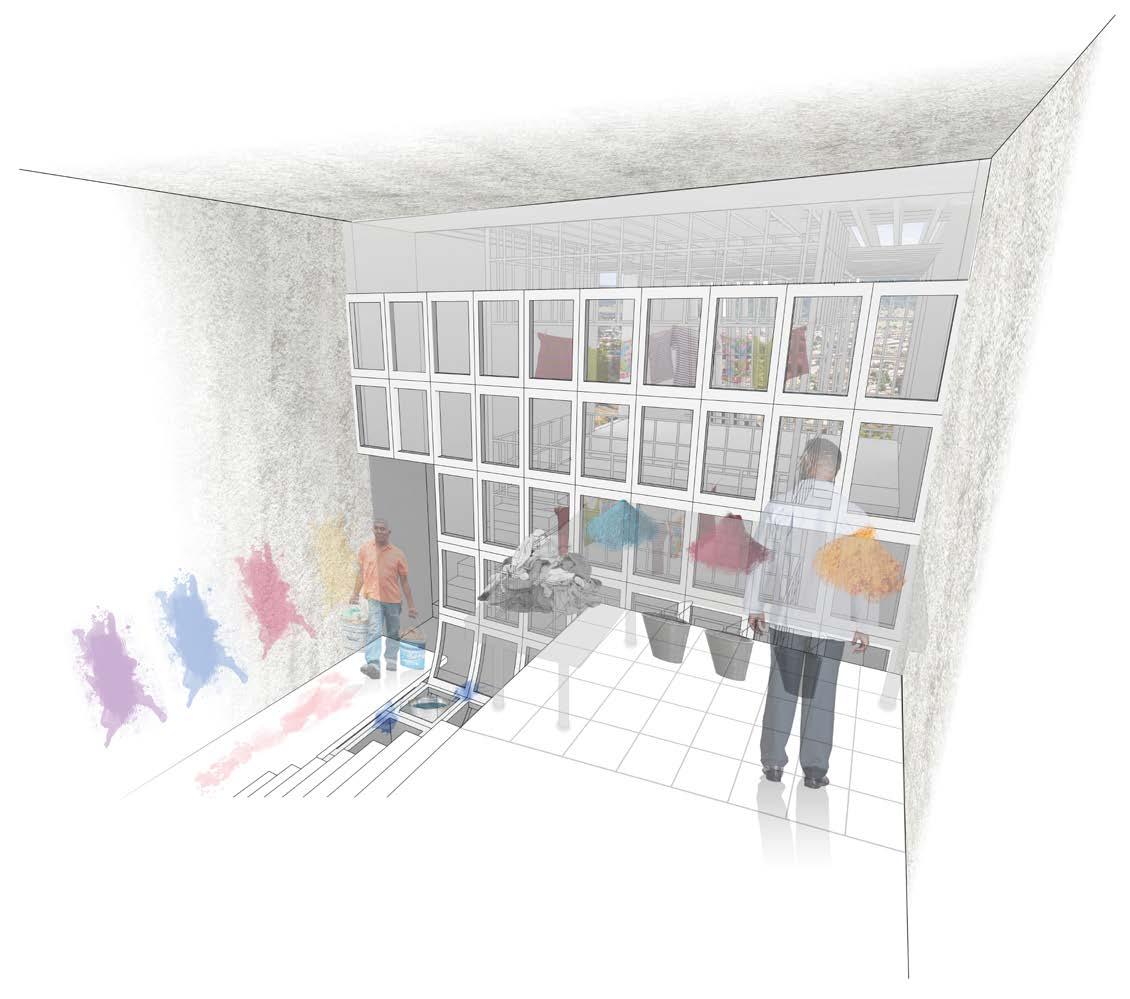 Interior perspectival rendering, portraying the space of dyeing, a space within a space elevated on the backside of the construct. This space takes advantage of its isolated qualities by acting as a white canvas to dye clothes. The adjacent wind funnel works in conjunction by allowing the hanging of attire for drying.
Interior perspectival rendering, portraying the space of dyeing, a space within a space elevated on the backside of the construct. This space takes advantage of its isolated qualities by acting as a white canvas to dye clothes. The adjacent wind funnel works in conjunction by allowing the hanging of attire for drying.
A temporary stop in action; interruption.
Having explored the potentials of architectural design addressing the issues within isolated settlement camps through the cold and warm interval havens, allowed for a reevaluation of necessities required by these displaced communities in a distinct scenario. A shift in perspective that challenges the architecture to respond to the various elements encountered throughout the journey each individual must endure before reaching their final destination.
From the moment a group of individuals is displaced, the arduous trek ahead becomes the main focal point before reaching a final goal. This long voyage involves a series of unknown variables forcing the users to experience a sense of uncertainty, fear and anguish towards what the future might hold for them. Time, energy and resources become of vital importance as there is no way to quantify how long the journey will take for each individual before they're too exhausted to continue or the food and water supply they carry are depleted. Additionally the physical and mental state of these groups begins to deteriorate as they progress through the uncharted paths contained within each region.
A place for thought and revitalization is often amiss, making it difficult for the individuals who are experiencing the struggle to have a moment of pause, replenishment, and resolve in order to be certain of the way they determine and plan the next steps to follow.
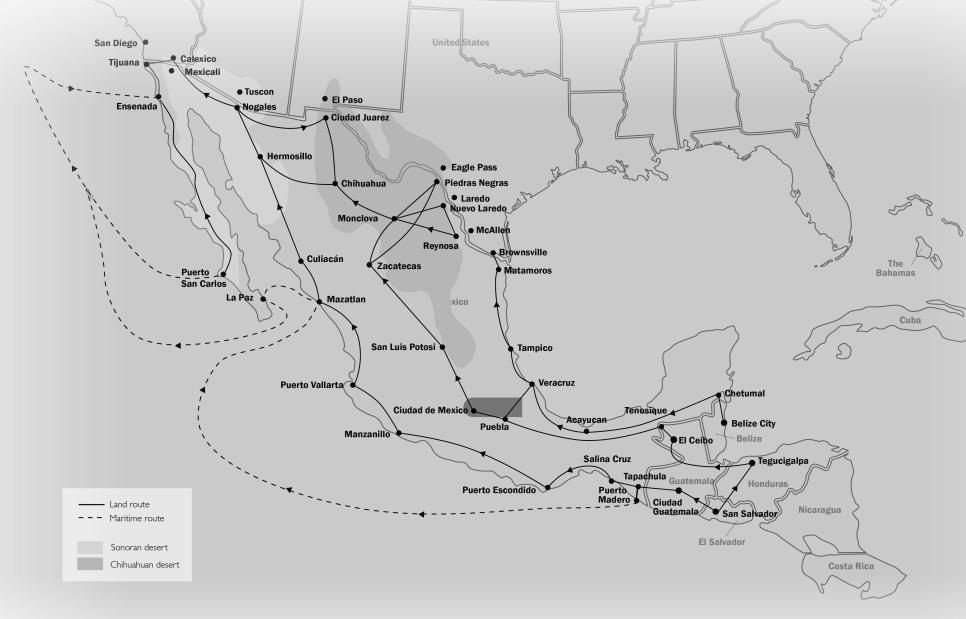 International Organization for Migration (IOM) map, showcasing a synthesis of mixed transit routes used by displaced communities across Central America and Mexico. The mark between Puebla and Mexico City locates the largest contingent of migrants during the 2018 migration caravan event.
International Organization for Migration (IOM) map, showcasing a synthesis of mixed transit routes used by displaced communities across Central America and Mexico. The mark between Puebla and Mexico City locates the largest contingent of migrants during the 2018 migration caravan event.
Fleeing a common cause has given displaced communities the opportunity to travel long distances in groups, which grants them a higher chance of survival and support within a community that seeks the same goal. In larger groups, individuals become harder to be targeted by human and drug trafficking groups which if captured would force them to inhumane labor. This type of migration relies in the constant communication and support within the group in order to set an organized itinerary they can all follow together throughout the journey.
BBC News depicts how most groups set off with the plan of reaching their final destination in mind, however different alternatives present themselves along the way, changing the outcome of each individuals story. From staying in small towns or big cities within the territories they’ve explored along the way, to the total surrendering of the trip due to either its demanding nature or the sudden news about the situation getting better back in their homeland, requiring them to consider a return to their place of origin. 6
The under-thought decision to overtake such an intense task has led many to travel in vain, only to be met with an overwhelming experience that offers little to no fruition and leads them back to the conditions that they first started with. Such is the case of Nelmy Ponce; a single mother traveling with her three children; who mentions in an interview how they were “tired of sleeping on the ground, rain or shine.” 7 Explaining her struggles throughout the journey, and the underwhelming conditions offered at what would’ve been her country of asylum.
6 BBC News, (2018), "Migrant caravan: What is it and why does it matter?". https://www.bbc.com/news/world-latinamerica-45951782.
7 Kevin Sieff and Joshua Partlow, (2018), "Faced with monthslong wait in Mexico, some caravan migrants decide to go home." The Washington Post, https://wapo.st/2ZuWMbD.
Photograph by Daniel Berehulak for The New York Times, documenting a group of displaced individuals walking along railroad tracks north through Mexico. Fig. 21.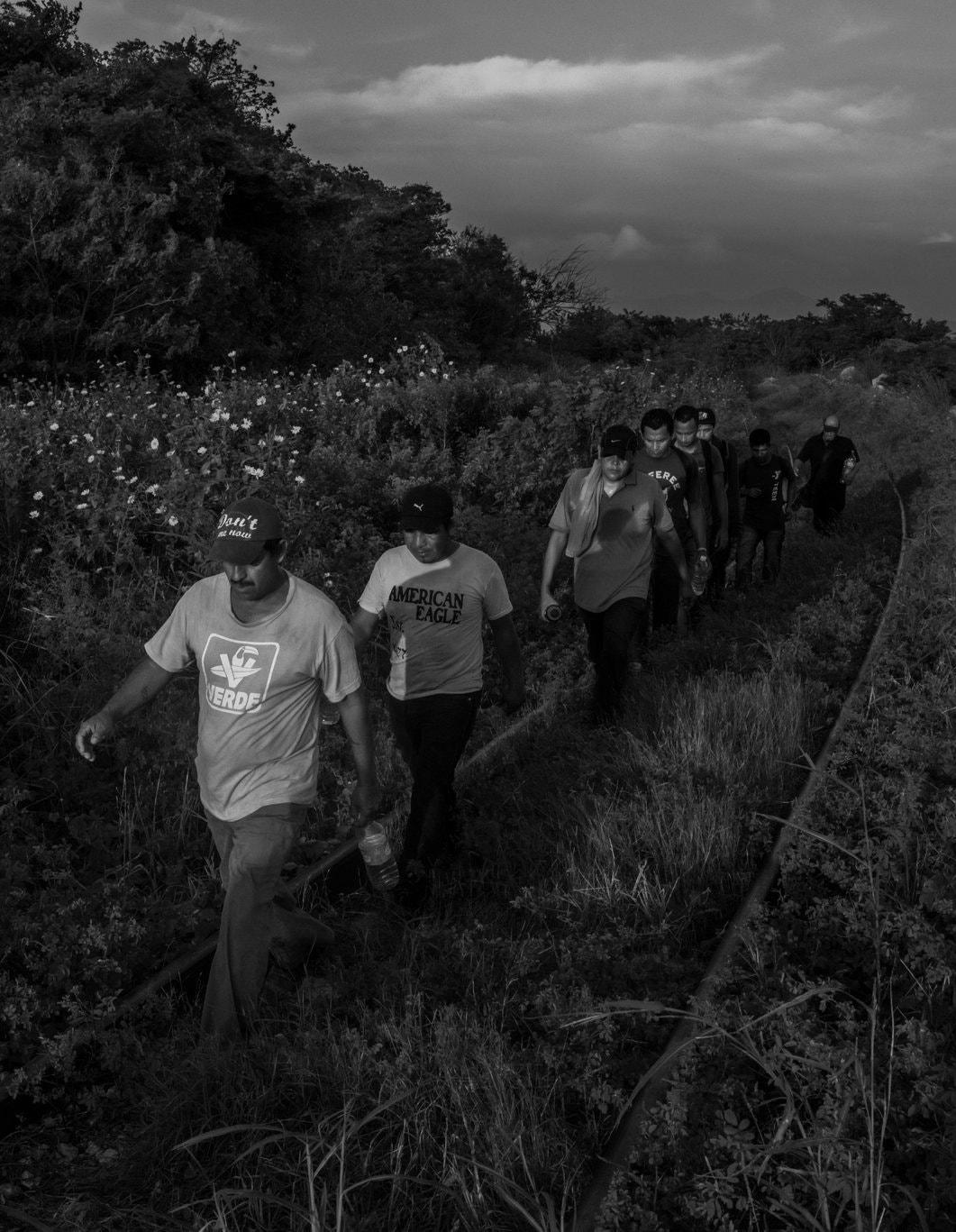
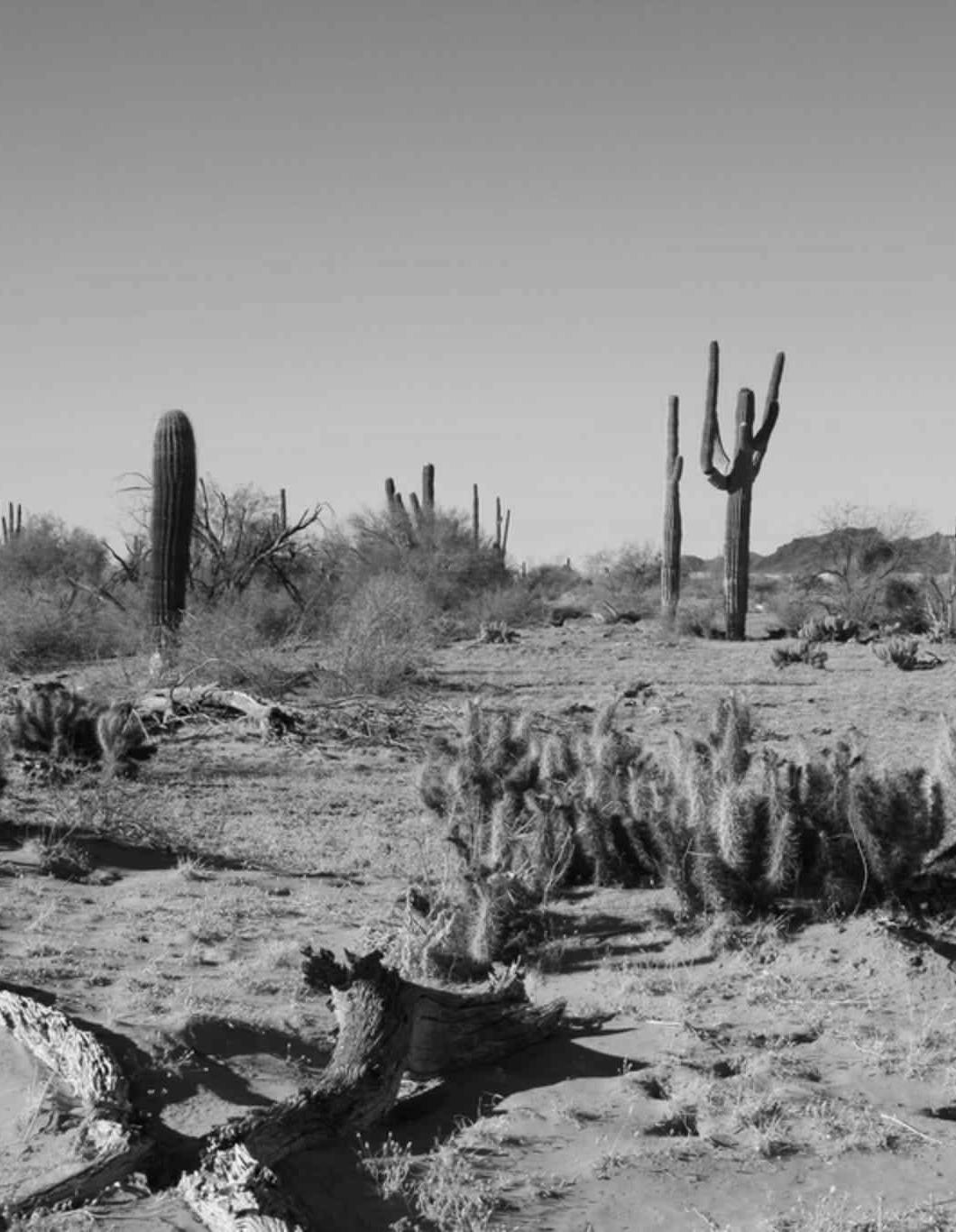
Deception through false hope is a common practice that affect these displaced communities and is stimulated by the unyielding philosophy of setting aside every aspect their current life in order to attain an opportunity of a life with dignity elsewhere, no matter the cost. Award-winning author Luis Alberto Urrea, portrays the events that took place in what’s commonly known as the Devil’s Highway at the United States and Mexico border. A duality of desolation is experienced by a group of desperate family men from Mexico, persuaded to travel from the hopeless and desolate conditions they lived in, into the extreme conditions of the desolate border contained within the Yuma Desert, becoming a cruel irony. 8
There is extensive value in granting these communities the ability to brainstorm all the possible outcomes that unveil themselves as they journey through unknown territories. Most of these decisions are made whilst clouded by the sudden hostility and desperation of the situation. Overcoming the uncertainty and distress of the moment is vital in making a logical and reasonable decision that takes into consideration how the lives and overall future of an entire family would change for the better or for the worse.
In order to understand the constant movement of communities and how they travel through the most basic means of walking on foot, parallels had to be drawn out of a series of pilgrimage trails at a global scale containing their own unique characteristics. The thorough exploration and comparison of pilgrimage routes around the world uncovered a wide spectrum of diverse possibilities on how to successfully intervene within a renowned route. The Way of Saint James in Spain, Kumano Kodō in Japan, Laugavegur Trail in Iceland and the Pilgrim Route in Mexico, are only a few of many trails communities around the world seek in order to fulfill their spiritual journey.
The act of walking, as a ritualistic and thought-provoking act, allows for the constant generation of thoughts, experiences and arrivals. Rebecca Solnit; author of Wanderlust: A History of Walking; mentions how, “Moving on foot seems to make it easier to move in time, the mind wanders from plans to recollections to observations.” 9 The opportunity of transforming through the act of walking is deeply implemented within the human being, awaiting its discovery and exploration.
Digital photograph by author of trails surrounding the Landmannalauger area, showcasing the considerably large scale comparison of the natural environment within Iceland against the tiny human scale. Fig. 23.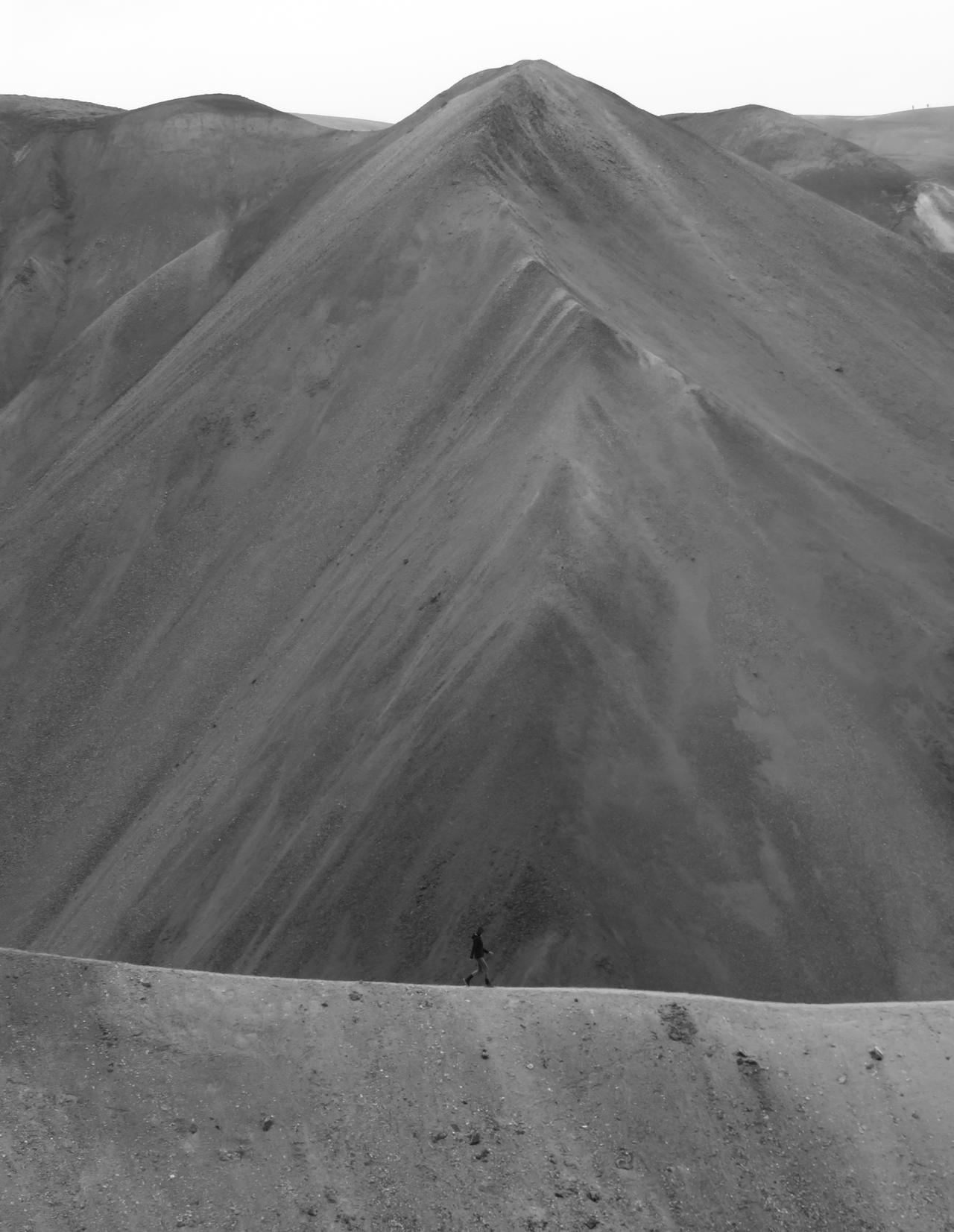
The Laugavegur trail case study in Iceland, focused on studying the personal experience of hiking the extremely irregular landscape conditions found within the area. Each day would require approximately a 10km trek before reaching a designated area to build a tent, eat, cleanse, reflect on the journey and rest for the night. A combination of skills, ranging from climbing and descending steep slopes and crossing bodies of water while carrying heavy luggage, demanded a complete devotion in mind and body to complete, lasting for a total of five days.
The study of the Laugavegur trail aided in the comprehension of what it means to walk long distances, from the careful management of resources and energy, to the understanding of varied physical endurance each individual can withstand. Each rest hut interval along the route emitted a sense of quintessential service that proved vital in the revitalization of each traveler.


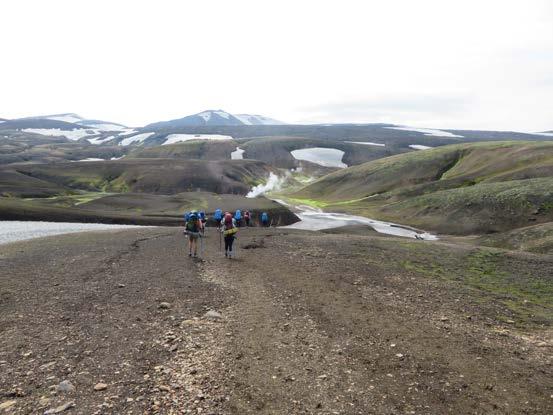
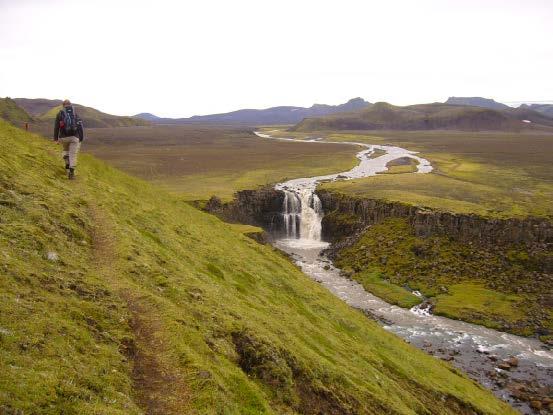 Elevation profile analysis of Laugavegur in Iceland, showcasing the various unique landscapes across the 53km trail, and locating the rest huts along the way.
Fig. 26.
Trek between Landmannalauger and Hrafntinnusker.
Fig. 24.
Elevation profile analysis of Laugavegur in Iceland, showcasing the various unique landscapes across the 53km trail, and locating the rest huts along the way.
Fig. 26.
Trek between Landmannalauger and Hrafntinnusker.
Fig. 24.
The historic Pilgrimage route of Kumano Kodō is a sacred territory in Japan where pilgrims from all over the world gather for spiritual growth. This territory is composed of an extensive interconnected network of pilgrimage routes historically traveled for centuries, leading to a series of shrines surrounded and uncovered by nature. The spiritual journey of Kumano Kodō is focused on the rural, nature-driven experience, with little to no infrastructure encountered throughout the route.
The study of Kumano Kodō aided in the comprehension of how nature impacts the spiritual journey of each traveler. The route devoid of built structures generates a reconnection of the users with their natural environment. As a territory, Kumano Kodō offers options in terms of unique paths and experiences that are tailored towards various destinations dependent on each individuals end goal.


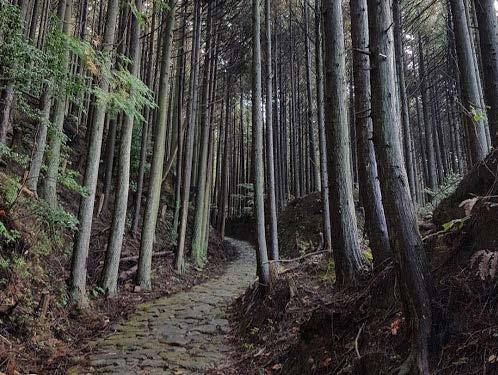
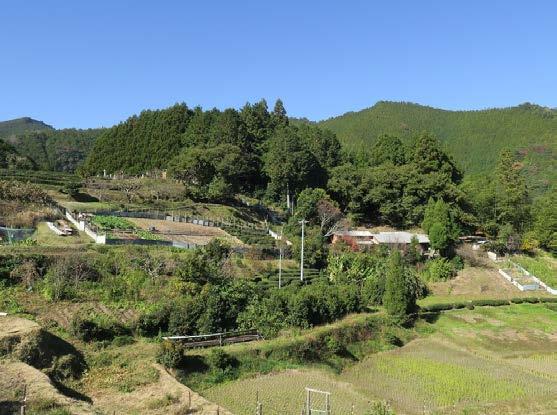 Trek between Takahara and Chikatsuyu-oji.
Fig. 27.
Trek between Tsugizakura-oji and Fushiogami-oji.
Trek between Takahara and Chikatsuyu-oji.
Fig. 27.
Trek between Tsugizakura-oji and Fushiogami-oji.
The Pilgrim Route gained its popularity thanks to the thousands of pilgrims that traveled from Ameca to Talpa in Jalisco, Mexico every year during Holy Week. The rising popularity from the overall surrounding areas encouraged the Secretary of Tourism to invest and commission a series of architectural projects to enrich the routes experience and inspire other pilgrims to visit.
Each of the projects throughout the route was assigned a renowned architect that would implement their personal take on how to intervene within the landscape, culminating in a collection of architectural experiences scattered throughout the route waiting to be discovered. These architectural constructs range in experience from sculptural elements that provide shade and trigger a sense of wonder, to havens where communities can take refuge for the night, to lookouts that allow the users to view the natural landscape, offering a wide variety of approaches towards what the meaning of pause could be.


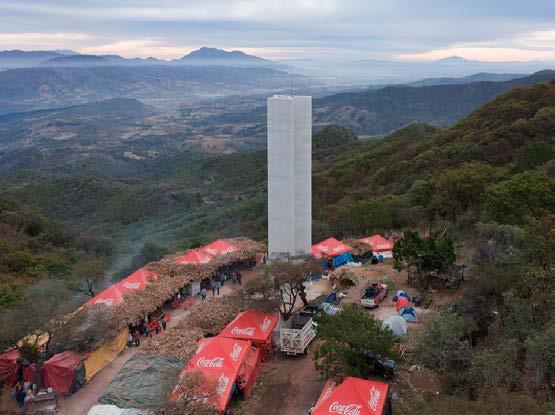
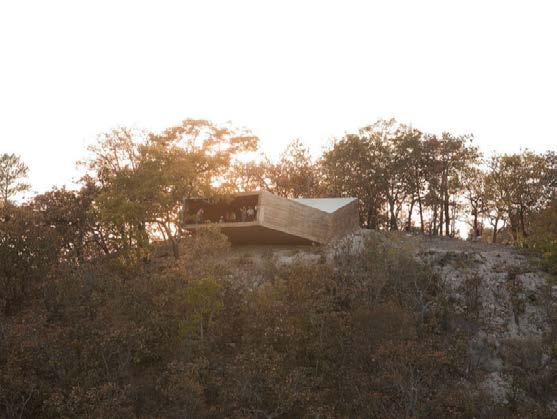 Pilgrim’s Column by Christ & Gantenbein.
Fig. 30.
Crosses Lookout Point by Elemental.
Pilgrim’s Column by Christ & Gantenbein.
Fig. 30.
Crosses Lookout Point by Elemental.
The study of the Pilgrim Route in Jalisco, Mexico aided in the comprehension of how architecture enriches an established route by addressing the experience and necessities of the users. The constructs strategically scattered throughout the trail are accompanied by service areas that prioritize the issues of: water, waste, shade, restrooms and way-finding. 10 Thes smaller scale structures managed to not only enhance the challenging trek from the town of Ameca to the town of Talpa de Allende, but also the living conditions of the local communities along the way.
The project as a whole manages to devote effort to the necessities of local communities and travelers alike, providing a series of spaces where groups may find ways of manifesting their inner needs. These necessities range from: expressing themselves creatively and interpreting the structures in unconventional ways, finding shelters that address the basic needs of a dwelling, encounter smaller scales structures that supplement the trail with spaces of cleansing and nourishment, and utilizing these constructs as milestones to form communal gatherings where the local community supplies the travelers with goods to keep them motivated for the exhausting journey ahead.
10 Ridhika Naidoo, godoylab: service areas for ruta peregrino, (2009), https://www.designboom.com/architecture/godoylab-service-areas-for-ruta-peregrino/
Sense of belonging by expressing emotions through art and utilizing the constructs in unconventional ways.
Public dwellings that incorporate the ephemeral qualities of the natural context to provide a place of rest for travelers.
Sustainable small scale structures, scattered throughout the route to fulfill hygienic purposes for pilgrims.
Designated areas for cooking, drinking and eating. A space of revitalization for short pauses along the route.
Constructs become part of the local community, incentivizing the production of goods and spaces for travelers.
Synthesis of necessities, as identified and categorized by the author, through the extensive research of The Pilgrim Route project in Mexico.2020 – Vestiges of Grief: an Impetus of Hope - Master's Research Project Thesis
Focused on the Master’s Research Project Thesis presented at the University of Florida’s College of Design, Construction and Planning, School of Architecture.
https://patron.uflib.ufl.edu/AA00081035/00001/citation
